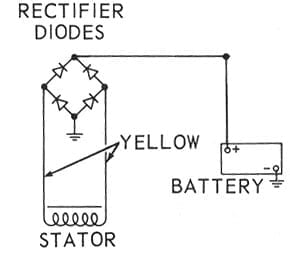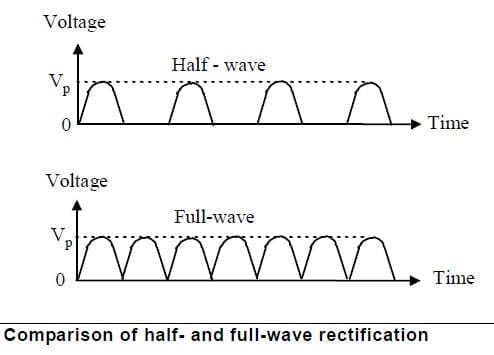Home › Forum › Ask A Member › RADIO SHACK RECTIFIER
- This topic has 24 replies, 7 voices, and was last updated 4 years, 3 months ago by
 garry-in-michigan.
garry-in-michigan.
-
AuthorPosts
-
December 14, 2019 at 2:40 pm #189323
THANKS FOR ALL THE REPLIES. I’M INTRIGUED BY THE BRIGGS AND STRATTON REGULATOR, BUT FROM IT’S PHYSICAL APPEARANCE, IT APPEARS TO BE NOTHING MORE THAT A BRIDGE RECTIFIER EVEN THOUGH IT IS CALLED A REGULATOR. DOES ANYONE KNOW FOR SURE WHETHER OR NOT IT IS AN ACTUAL REGULATOR OR SIMPLY A RECTIFIER?
AS FAR AS THE RECTIFIER GOES, WHAT I AM REALLY WONDERING IS WHETHER I CAN USE SAY A 35 OR 50 AMP RECTIFIER WITH VOLTAGE RATINGS OF 400,600 OR EVEN 1000 VOLTS. FOR INSTANCE, I CAN GET A 50 AMP 1000 VOLT RECTIFIER OUT OF CHINA FOR LESS THAN A DOLLAR. IF THAT WILL WORK, AND I THINK IT WILL, I’M ALL IN AND I’LL BUY A DOZEN OF THEM.
BACK TO THE B&S, IF IT IS TRUELY A REGULATOR, I WOULD GO THAT ROUTE. THERE IS CERTAINLY AN ADVANTAGE TO REGULATING THE VOLTAGE EVEN THOUGH IT IS NOT ABSOLUTELY NECESSARY IN MY APPLICATION (MARK 55). I’M GOING TO LOOK INTO THAT FURTHER, BUT IN THE MEANTIME, IF ANYONE KNOWS FOR SURE THAT IT REGULATES AS WELL AS RECTIFIES, THAT WOULD BE VERY HELPFUL.
See my answer above. A 50 Amp 1000 Volt will be fine. I suggested 4x the normal voltage. These unregulated motors can go up around 16V, so 4x 16=64V. Not quite 4 times 12 (48) but good enough if cooled enough.
Furthermore 1000 Volt is overkill but fine. In fact, it will provide better protection against overvoltages which occur during loose connections, etc, which are the prime killers of outboard rectifiers.
Now for the rest of the story. Didn’t your Merc originally come with a selenium rectifier and positive ground? Have you converted it to negative ground? The bridge rectifier you are looking at will work nicely if negative ground. In fact it probably will actually give higher output voltage than the old selenium rectifier You might want to monitor the voltage awhile to see how it’s doing.
Do you even know what a “bridge rectifier” is? A bridge rectifier will have 4 diodes inside, and two wires coming from the alternator, one wire going to the battery, and one wire going to ground.. Very often the ground “wire” is not an actual wire, but the case serves as a ground connection.
-
This reply was modified 4 years, 4 months ago by
 frankr.
frankr.
December 14, 2019 at 2:48 pm #189328December 14, 2019 at 3:24 pm #189331THANKS AGAIN FOR THE REPLIES. YES, I DO KNOW WHAT A BRIDGE RECTIFIER IS. IT CONVERTS AC TO DC, BUT DOES NOTHING TO REGULATE VOLTAGE. AT HIGH RPMS THE VOLTAGE CAN GET WAY OUT OF HAND AND BOIL OFF THE ACID IN THE BATTERY. NOT FATAL, BUT NOT DESIREABLE EITHER. MY ENGINE IS A THE MARK 55 AND ORIGINALLY CAME WITH A SELENIUM RECTIFIER AS YOU INDICATE, AND IT HAS A NEGATIVE GROUND, SO IT IS IDEALLY SUITED FOR A BRIDGE RECTIFIER. I ACTUALLY HAVE TWO OF THESE ENGINES AND HAVE ALREADY INSTALLED THE RADIO SHACK RECTIFIER ON ONE. IT IS WORKING JUST FINE, WITH THE EXCEPTION OF THE VOLTAGE PROBLEM WHICH CANNOT BE AVOIDED WITHOUT SOME SORT OF A REGULATOR. AS INDICATED, I’LL BE LOOKING INTO THE B&S REGULATOR TO HOPEFULLY RESOLVE THAT ISSUE, BUT HAVEN’T DONE SO YET
TO ADDRESS THE OVERKILL ISSUE, THE ONLY REASON I’M LOOKING AT BRIDGE RECTIFIERS WITH 1000 VOLT RATINGS IS AVAILABILITY. AND PRICE. I HAVE THE PRICE OF A 35 AMP 1000 VOLT RECTIFIER DOWN TO ABOUT .75 APIECE. I DIDN’T WANT TO BUY THEM IF THERE IS ANY DANGER OF FRYING MY BATTERY OR STATOR, BUT IT APPEARS THAT IS NOT A PROBLEM. THAT BEING THE CASE, UNLESS THE B&S REGULATOR PANS OUT, I’LL GO AHEAD AND ORDER THEM.
IF ANYONE ELSE IS LOOKING FOR THESE RECTIFIERS, YOU CAN GET THEM THROUGH ALIEXPRESS FOR UNDER A DOLLAR AND IN SOME CASES WITH FREE SHIPPING.
December 14, 2019 at 9:47 pm #189351I highly doubt that the B&S is voltage regulated. Most likely a bridge rectifier also called a full wave rectifier.
The battery acts as the voltage regulator.
If the system is constantly over charging the battery, boiling it’s water away, you can disconnect a charging lead from the stator to the rectifier turning it into a half wave rectifier. . This will reduce its current output. Also a switch could be put into a lead. High voltage isn’t usually much of a problem unless you are powering fancy electronic devices like a chart plotter, etc.
Usually in a power supply capacitors are used to smooth or average the waveform. The low cost marine rectifiers that do not regulate voltage use the boat battery to smooth the waveform.
You may also want to look into a rectifier/voltage regulator like used on the OMC motors in the 1990’s. They are going to run you $100 or more unless you can find a used working one.
CDI electronics sells such regulators.
December 15, 2019 at 8:40 am #189363Agree with the half-wave idea to cut the overcharge situation, if necessary However, I think the removed stator wire has to be grounded to make it work. Right????
December 15, 2019 at 1:52 pm #189376I HAVE BEEN UNABLE TO DETERMINE WHETHER THE B&S REGULATOR IS AN ACTUAL REGULATOR OR JUST A RECTIFIER, BUT AM REASONABLY SURE IT IS THE LATTER. THAT BEING THE CASE, I FOUND THESE RECTIFIERS ON EBAY AT A COST OF .68 APIECE AND ORDERED A BUNCH OF THEM JUST TO HAVE ON HAND. I WOULD LIKE TO ADD A CAPACITOR TO SMOOTH OUT THE RIPPLE, BUT DON’T KNOW HOW TO FIGURE OUT THE RIGHT ONE. I CAN UNDERSTAND SOME OF THE PRINCIPLES OF ELECTRONICS, BUT WHEN I GET TO THE MATH PART, I DON’T HAVE A CHANCE. ANY HELP ON THAT ISSUE WOULD BE APPRECIATED.
December 15, 2019 at 2:17 pm #189378One wire from the coil would have to be grounded – right ! In this case, the battery is the capacitor.


-
This reply was modified 4 years, 4 months ago by
 garry-in-michigan.
garry-in-michigan.
-
This reply was modified 4 years, 4 months ago by
 garry-in-michigan.
garry-in-michigan.
December 15, 2019 at 4:55 pm #189389Agree with the half-wave idea to cut the overcharge situation, if necessary However, I think the removed stator wire has to be grounded to make it work. Right????
I don’t know. Looking at the schematic you posted, maybe so. I was working with a 1976 35hp motor and the stator had three wires, I believe.
I discussed this with a CDI tech a couple of years ago and grounding one end of the stator wasn’t mentioned.
December 15, 2019 at 5:03 pm #189390The 3-wire stator is 3-phase. A horse of a different color.
December 16, 2019 at 8:09 am #1894213 phase rectifiers also cheap…
https://www.ebay.ca/sch/i.html?_nkw=three+phase+rectifier but they do not regulate voltage
Joining AOMCI has priviledges 🙂
-
This reply was modified 4 years, 4 months ago by
-
AuthorPosts
- You must be logged in to reply to this topic.



